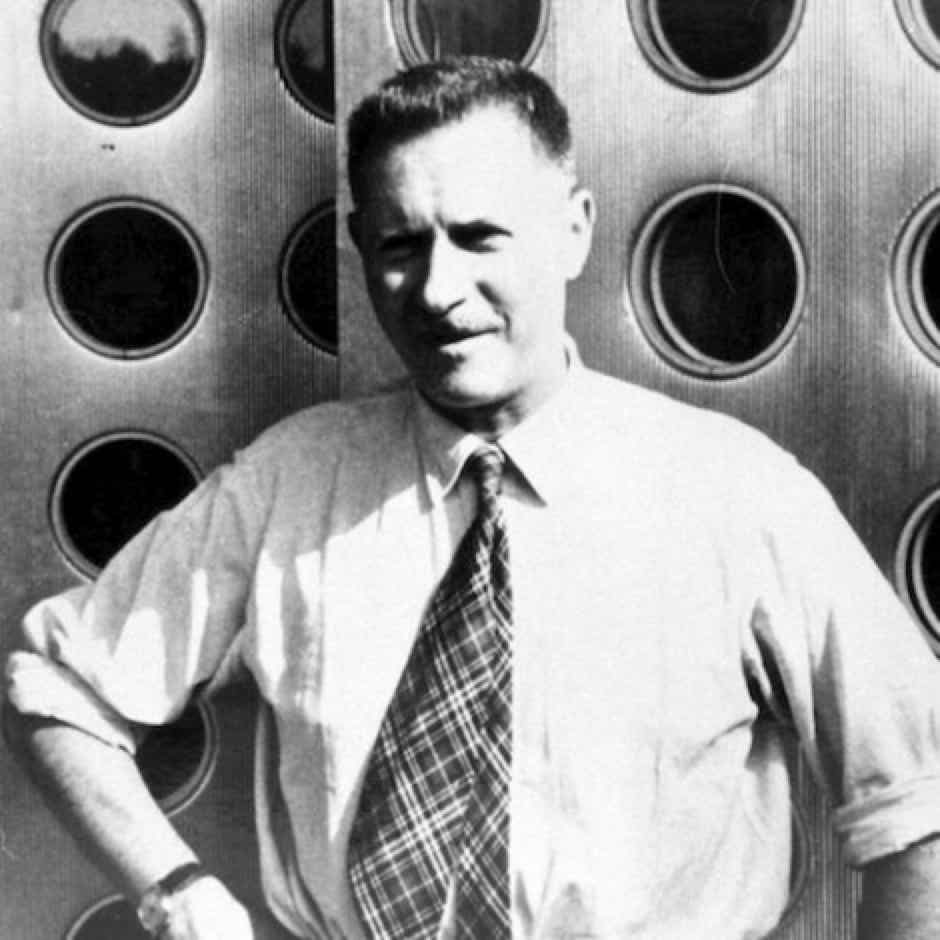Chaise Tout Bois is the only chair by the French 'constructeur' and designer Jean Prouvé that is made entirely out of wood. The design is very similar to Prouvé's famous Standard chair, but wood was substituted for the metal base due to the scarcity of metal during the Second World War.
The form of the Chaise Tout Bois articulates Prouvé's intention to provide added strength at the transition point between the seat and backrest, where the load weight of the human anatomy is greatest. The profile of the rear frame section – back legs and backrest support – makes reference to this load transfer and is a typical characteristic of Prouvé's designs for both furniture and architecture.
Prouvé created several prototypes of this chair during the war for the purpose of testing its structural strength as well as the joints, leg position and connection between the seat and back. The chosen type of wood depended on what was available at the time.
After the war, there was once again a sufficient supply of oak, which due to its hardness and strength was commonly used in France to construct ships and cathedral roofs. As these properties are also ideal for an all-wood chair, the Chaise Tout Bois was ultimately made out of oak and plywood – also offered in dark-stained versions when requested by Jean Prouvé's customers.
In 1947, Prouvé won an award for the Chaise Tout Bois in the 'Meubles de France' competition. The concept of the competition was to find attractive, high-quality, mass-produced furnishings to meet the post-war needs of society – particularly refugees and young married couples. Later the Chaise Tout Bois was replaced by a knock-down version in metal and wood, which was then supplanted by Model No. 305, likewise combining a metal base with a wooden seat and backrest – known today as the Standard chair.
Chaise Tout Bois by Vitra corresponds to one of Jean Prouvé's design variants from 1941, whose construction does not require a single screw. The height and seat geometry are the same as those of the Standard chair and thus meet current norms and requirements. The warm look and feel of wood contrasts appealingly with the practical structural design, which is typical of Prouvé's functional approach.
Chaise Tout Bois is available in light oak or dark-stained oak.
Chaise Tout Bois & Chaise Standard
Jean Prouvé

Jean Prouvé, born in 1901 in Paris, France, apprenticed as a silversmith with Emile Robert, Enghien and Szabo in Paris. In 1924 he created his own workshop in Nancy and in 1925 produced the first furniture in folded sheet steel. In 1930, he co-founded the association of artists "Union des Artistes Modernes" (U.A.M.), in 1931 he created "Les Ateliers Jean Prouvé". This is where many pieces of furniture saw the light of day in the 1930s as well as the first prefabricated architectural elements, for example for the “Maison du Peuple” in Clichy (in collaboration with the architects Beaudoin and Lods), which made a great impression thanks to its steel and glass structure.
During the war, due to the scarcity of steel, furniture was made of wood, and simple houses made of prefabricated elements were designed. From 1940, Jean Prouvé was a member of the Resistance and after the liberation of Nancy, having become mayor of the city, he created and built houses for the homeless. In 1947, Jean Prouvé set up the “Maxéville” factory where 200 employees produced prefabricated houses and schools in 25,000 m2 in addition to furniture. To be able to respond to the growing need, a department entirely devoted to furniture was created in 1949. Steph Simon was in charge of exclusive marketing.
Following disagreements with the main shareholder, Jean Prouvé left the company in 1953, in 1954 he designed and built his own house. From 1957 to 1968 he headed the construction office of the Compagnie Industrielle de Matériaux de Transport (CIMT) in Paris, and from 1968 to 1984 he headed an office in Paris as an independent consulting architect. From 1957 to 1970 he held a professorship at the Conservatoire des Arts et Métiers (CNAM). In 1971 he chaired the jury of the competition for the construction of the Center Pompidou in Paris and defended the project of Renzo Piano and Richard Rogers there.
From 1980 to 1984, Jean Prouvé continued to develop and improve the design of his furniture. He died in Nancy in 1984. In many works, Jean Prouvé succeeded in combining his expectations from the point of view of functionality, suitability of material and economy with the complex requirements of series production. In 2002 Vitra began to rebroadcast the creations of the great manufacturer in the form of reissues in close collaboration with the Prouvé family.
Price Guarantee
Offering design at the right price is an integral part of our work. If you find the same item at a lower price at another retailer, delivery included, we will not only match it, but even offer you a better price.
How to take advantage of it?
We compare our prices every day with all authorized retailers in Europe. If nevertheless you find cheaper, contact us for a counter-proposal.
We must be able to verify that the item is authentic, new, perfectly identical (size, materials, color, etc.)
and that it is not part of a campaign or temporary destocking.
The valid basis is, for example, a current quote or a direct link to another retailer's website where the lower price is indicated. An email image is invalid, the original email must be forwarded.
The offer does not apply to orders already placed and cannot be combined with any of our other offers or promotions.
Ce site web utilise les cookies techniques pour fonctionner.
Vous pouvez les refuser, mais perdrez alors la possibilité d'acheter.
OK
Refuser